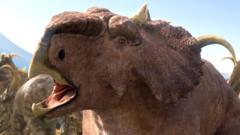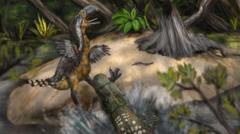Hidden deep within Alberta's lush forests lies Pipestone Creek, a site that has recently come to prominence due to the extraordinary discovery of a mass grave of dinosaurs, collecting attention for its compelling narrative. The area, ominously dubbed the "River of Death," provides a chilling glimpse into a moment of catastrophe that occurred 72 million years ago, burying countless dinosaurs in an instant.
A team of paleontologists, spearheaded by Professor Emily Bamforth, is meticulously excavating this significant site to piece together clues that explain the conditions which led to the demise of these prehistoric creatures. The research begins with the use of heavy tools, such as sledgehammers, to break through layers of rock, followed by careful and delicate excavation techniques to uncover fossilized bones.
During their dig, the team has unearthed thousands of bones from a species known as Pachyrhinosaurus. Prof. Bamforth, alongside her loyal canine companion Aster, expressed excitement as various bones, including hip and toe fragments, surfaced from the ground. "The density of the bones is jaw-dropping," she remarked, with estimates suggesting up to 300 bones could be found in just one square meter of the site. So far, the excavation team has uncovered a tennis court-sized area, with indications that the bone bed stretches for an entire kilometer into the hillside.
“It's a snapshot of a single community of a single species of animal, allowing us access to a significant sample size,” Prof. Bamforth explained, emphasizing the unprecedented wealth of fossil material available for study.
As the team investigates the surrounding area, known as the Deadfall Hills, they hope to learn more about the ancient ecosystem that once thrived in this region. There, they find bones from a larger duck-billed dinosaur called Edmontosaurus, aiding in the reconstruction of the ecological landscape. Jackson Sweder, a collection manager at the nearby Philip J Currie Dinosaur Museum, is examining a potential dinosaur skull, further enriching the collaborative research happening in Alberta.
In piecing together the puzzle of this mass grave, scientists hypothesize that the herd of Pachyrhinosaurus may have been caught in a flash flood linked to severe weather patterns. The animals, which were migrating together for seasonal feeding, were rendered nearly helpless by the oncoming torrent of water. Prof. Bamforth detailed how, due to their size and ungainly nature, the dinosaurs would have struggled to escape the catastrophic event.
This rich site provides a unique and invaluable opportunity not only to accumulate a plethora of fossil specimens but also to pose and explore questions about prehistoric life and the dynamics of ancient ecosystems.
The ongoing excavations at Pipestone Creek and the surrounding areas promise to yield more exciting discoveries, ensuring that this research continues to shed light on how this disaster impacted the Pachyrhinosaurus and the surrounding ecosystem. As the team wraps up their current excavation phase, they are keenly aware that despite the vast amount already uncovered, numerous prehistoric secrets still lie just beneath the surface, waiting to be revealed. The new series "Walking With Dinosaurs" explores these exciting discoveries and will premiere on BBC One, encapsulating this monumental scientific adventure.



















